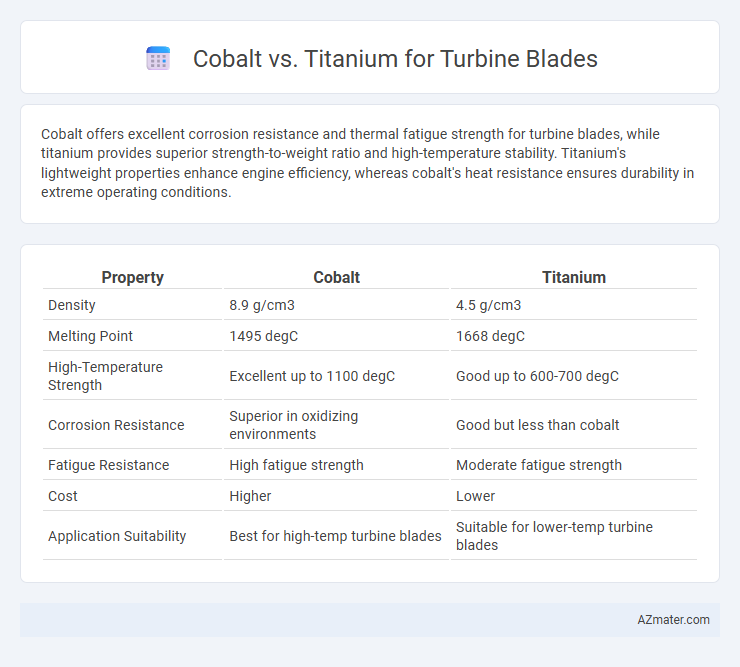Cobalt offers excellent corrosion resistance and thermal fatigue strength for turbine blades, while titanium provides superior strength-to-weight ratio and high-temperature stability. Titanium's lightweight properties enhance engine efficiency, whereas cobalt's heat resistance ensures durability in extreme operating conditions.
Table of Comparison
| Property | Cobalt | Titanium |
|---|---|---|
| Density | 8.9 g/cm3 | 4.5 g/cm3 |
| Melting Point | 1495 degC | 1668 degC |
| High-Temperature Strength | Excellent up to 1100 degC | Good up to 600-700 degC |
| Corrosion Resistance | Superior in oxidizing environments | Good but less than cobalt |
| Fatigue Resistance | High fatigue strength | Moderate fatigue strength |
| Cost | Higher | Lower |
| Application Suitability | Best for high-temp turbine blades | Suitable for lower-temp turbine blades |
Introduction to Turbine Blade Materials
Turbine blade materials must exhibit exceptional high-temperature strength, corrosion resistance, and fatigue durability to withstand extreme operating conditions. Cobalt alloys offer superior hot corrosion resistance and thermal fatigue strength, making them suitable for the hottest sections of turbine engines. Titanium alloys provide excellent strength-to-weight ratio and oxidation resistance but are generally limited to cooler sections due to lower melting points compared to cobalt-based superalloys.
Overview of Cobalt and Titanium Alloys
Cobalt alloys exhibit exceptional high-temperature strength, corrosion resistance, and wear resistance, making them suitable for turbine blades exposed to extreme heat and stress. Titanium alloys offer a favorable strength-to-weight ratio, excellent corrosion resistance, and good fatigue performance but generally have lower high-temperature capabilities compared to cobalt alloys. The choice between cobalt and titanium alloys for turbine blades depends on specific engine requirements, operating temperatures, and mechanical performance needs.
Mechanical Strength Comparison
Cobalt alloys exhibit superior high-temperature strength and excellent wear resistance, making them ideal for turbine blades exposed to severe thermal and mechanical stress. Titanium alloys offer a high strength-to-weight ratio and good corrosion resistance but generally have lower creep resistance and mechanical strength at elevated temperatures compared to cobalt. In turbine blade applications requiring extreme thermal endurance and mechanical reliability, cobalt-based materials typically outperform titanium alloys in terms of sustained mechanical strength and durability.
Corrosion and Oxidation Resistance
Titanium exhibits superior corrosion resistance in marine and chemical environments compared to cobalt, due to its stable oxide film that prevents further degradation. Cobalt-based alloys provide exceptional oxidation resistance at high temperatures, making them ideal for turbine blades exposed to extreme heat. The choice between cobalt and titanium depends on operating conditions, with cobalt favored for high-temperature oxidation resistance and titanium for enhanced corrosion resistance.
High-Temperature Performance
Cobalt alloys exhibit exceptional high-temperature strength and oxidation resistance, making them ideal for turbine blades exposed to extreme thermal environments. Titanium alloys offer lower density and good corrosion resistance but tend to suffer from reduced strength and creep resistance at temperatures above 600degC, limiting their use in high-temperature turbine applications. The superior thermal stability and hot corrosion resistance of cobalt-based superalloys ensure sustained performance and durability in turbine blades operating at temperatures exceeding 900degC.
Fatigue and Creep Resistance
Cobalt alloys exhibit superior creep resistance and maintain strength at high temperatures, making them ideal for turbine blade applications where prolonged exposure to extreme heat is critical. Titanium alloys offer excellent fatigue resistance due to their high strength-to-weight ratio and corrosion resistance but generally perform less effectively than cobalt in sustained high-temperature environments. For turbine blades, cobalt's ability to resist creep deformation under cyclic thermal and mechanical stress advantages it over titanium in long-term durability.
Manufacturability and Machinability
Cobalt alloys offer excellent manufacturability for turbine blades due to their superior hot corrosion resistance and ease of casting into complex shapes, while titanium requires more precise control during forging and machining because of its high strength-to-weight ratio. Titanium's machinability is generally lower compared to cobalt, as it tends to cause rapid tool wear and requires specialized cutting tools and coolant management. Manufacturing turbine blades from cobalt allows for more straightforward post-processing, whereas titanium demands advanced techniques to maintain structural integrity and surface finish.
Cost and Availability Analysis
Cobalt alloys, known for their superior corrosion resistance and high-temperature strength, generally incur higher material costs compared to titanium, which benefits from abundant availability and lower raw material expenses. Titanium's widespread availability and lower density contribute to reduced manufacturing and transportation costs, making it a cost-effective option for turbine blades in volume production. However, cobalt's specialized properties and supply chain volatility can drive price fluctuations, impacting overall cost-effectiveness in turbine blade applications.
Applications in Aerospace and Power Generation
Cobalt alloys exhibit excellent high-temperature strength and corrosion resistance, making them ideal for turbine blades in aerospace engines where thermal fatigue and oxidation are critical concerns. Titanium alloys offer a lower density and superior strength-to-weight ratio, enhancing fuel efficiency and performance in aerospace applications, but they have lower temperature tolerance compared to cobalt. In power generation, cobalt-based superalloys are preferred for gas turbine blades due to their ability to maintain mechanical integrity at temperatures exceeding 1000degC, whereas titanium is less common due to its limited high-temperature capabilities.
Summary: Choosing Between Cobalt and Titanium
Cobalt alloys offer superior corrosion resistance and high-temperature strength, making them ideal for turbine blades exposed to extreme heat and oxidative environments. Titanium alloys provide excellent strength-to-weight ratio and resistance to fatigue, suitable for applications where weight reduction and durability are critical. Selecting between cobalt and titanium depends on the specific operational demands, balancing temperature resilience and mechanical performance for optimal turbine blade efficiency.

Infographic: Cobalt vs Titanium for Turbine Blade
 azmater.com
azmater.com